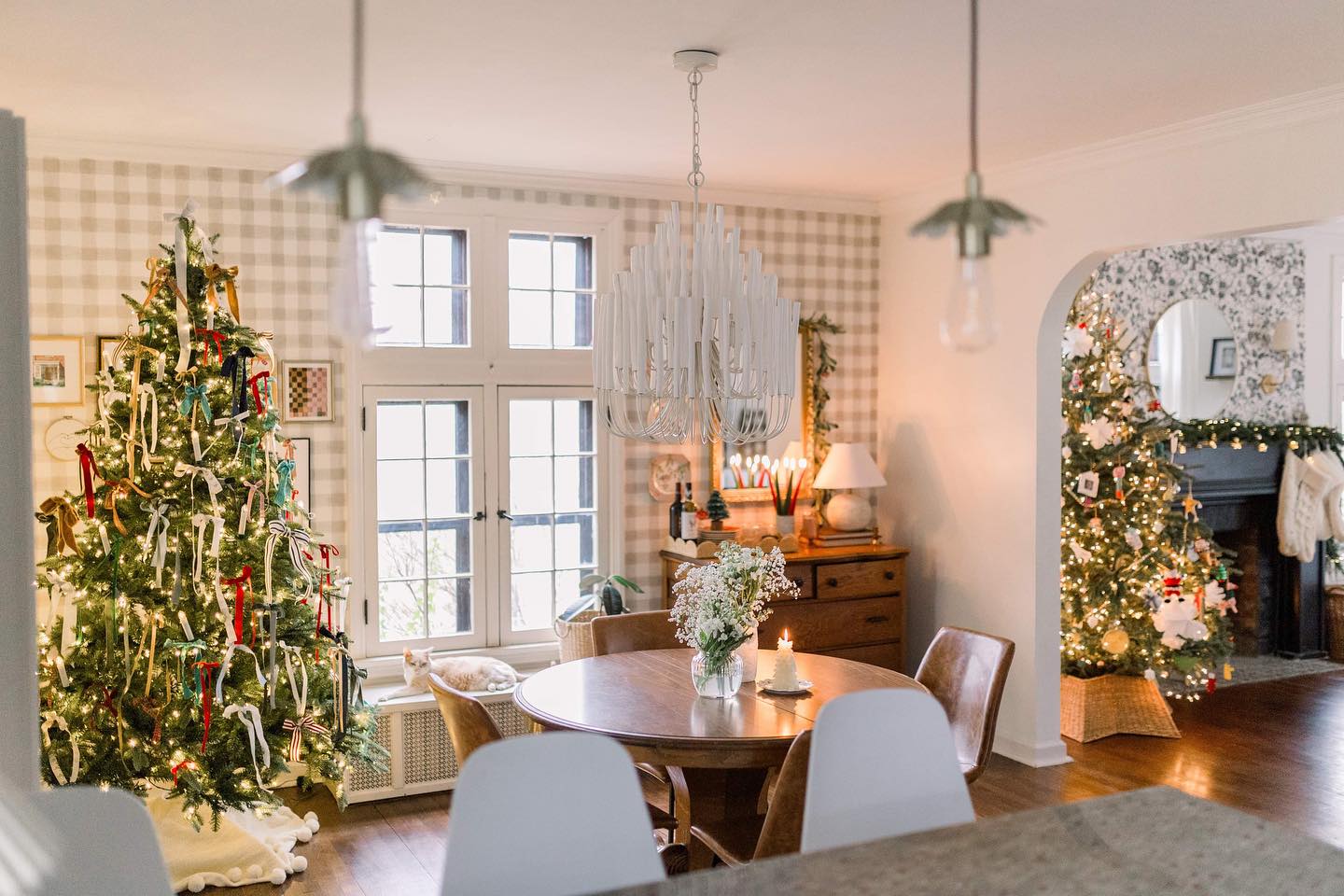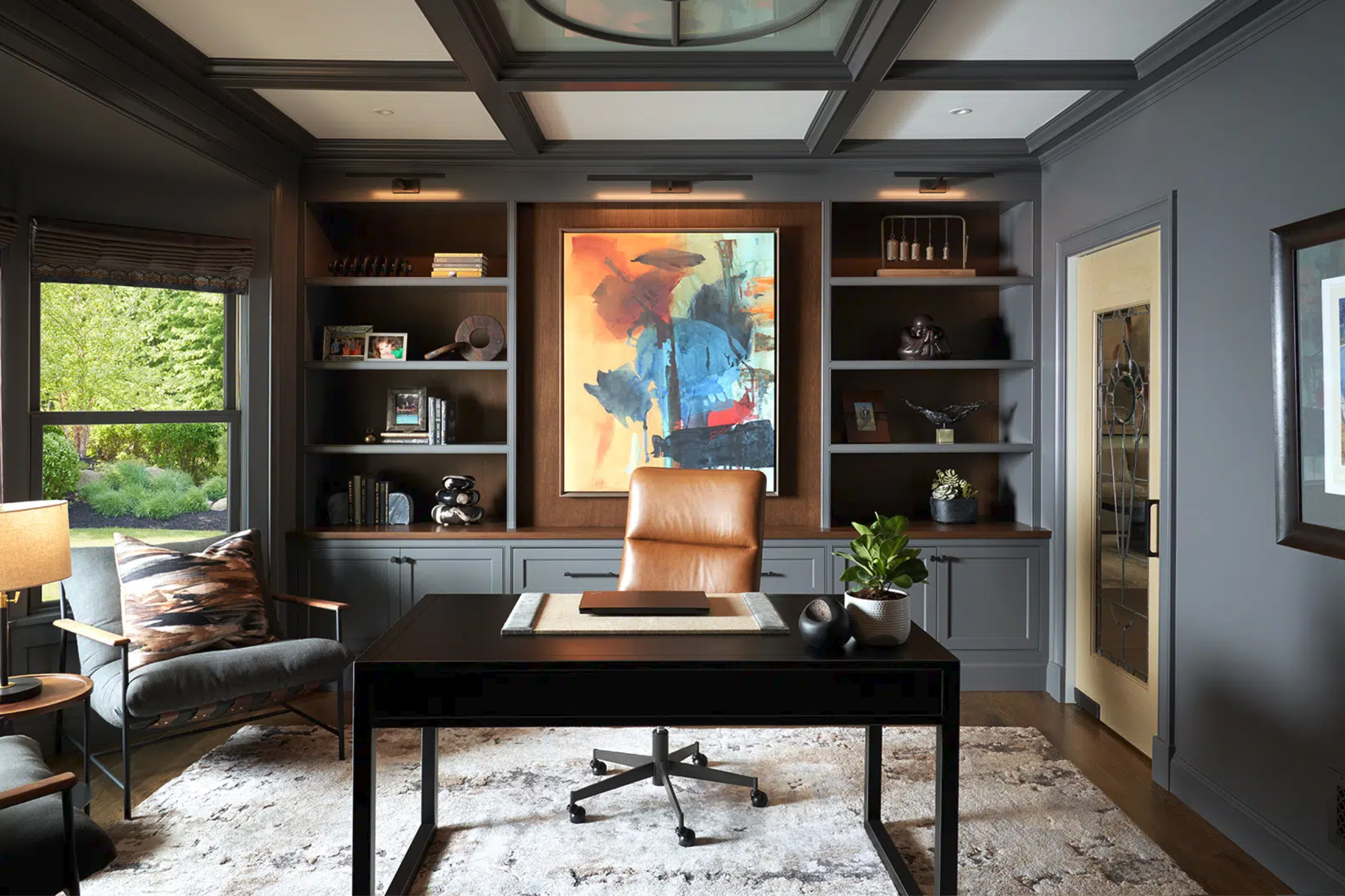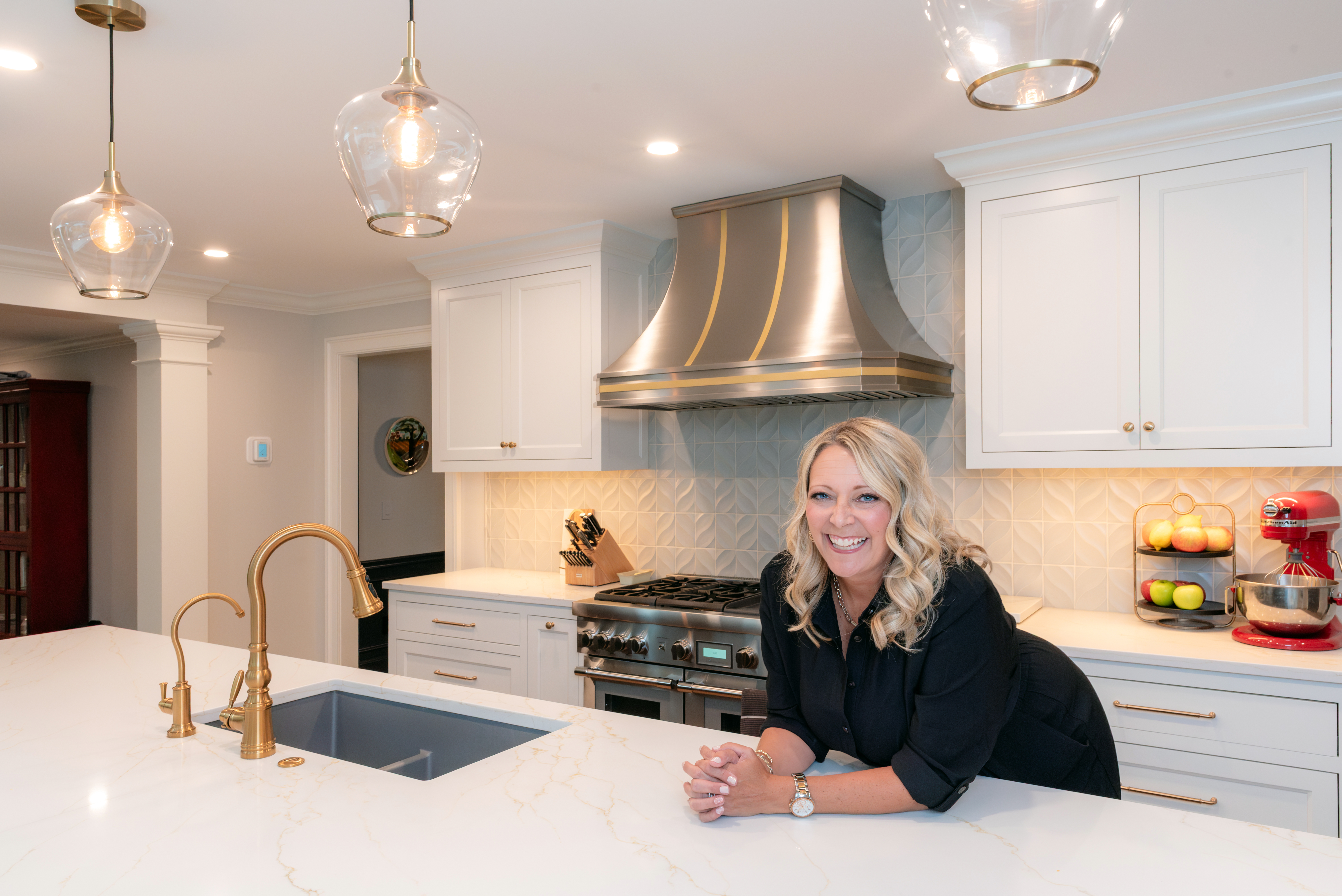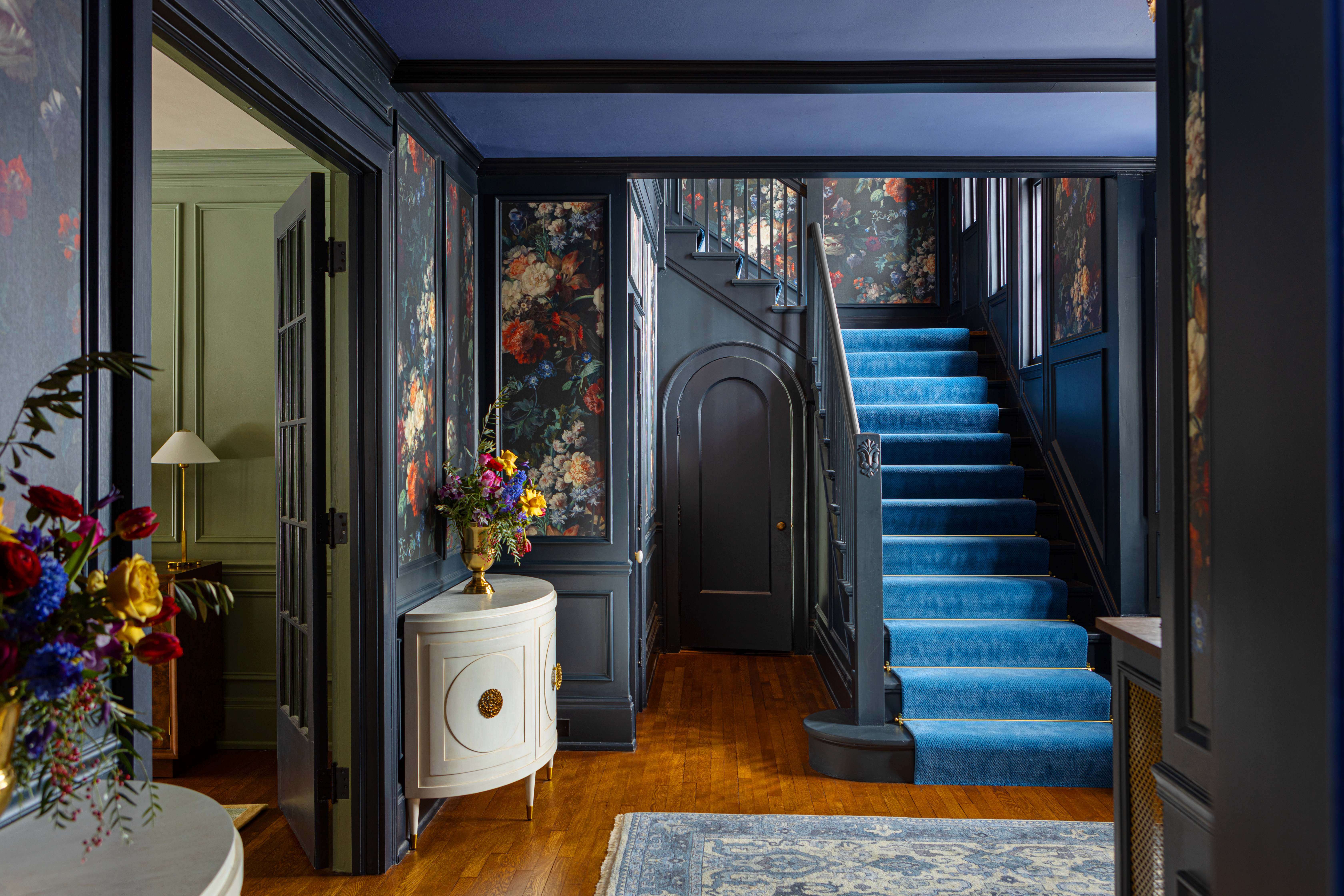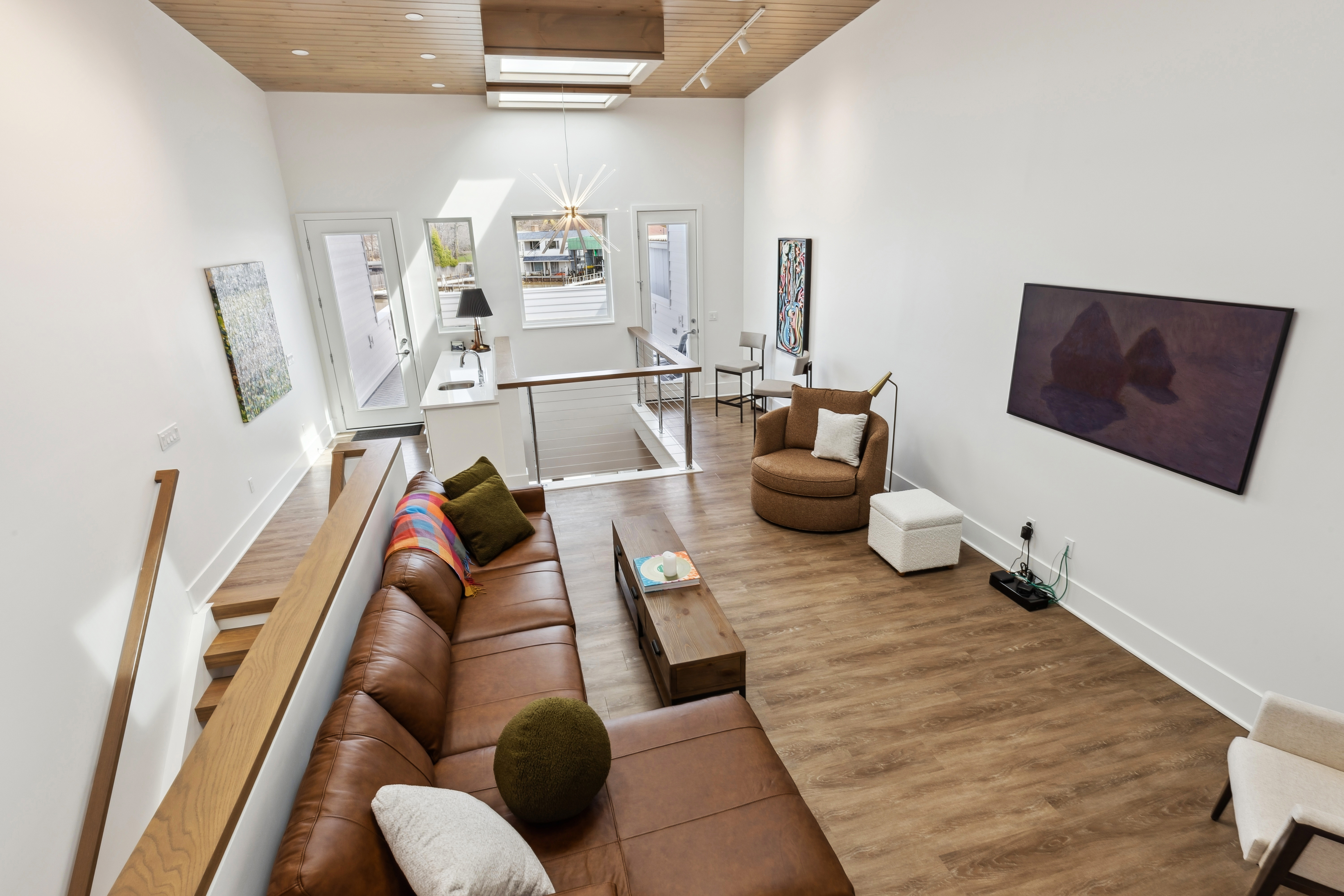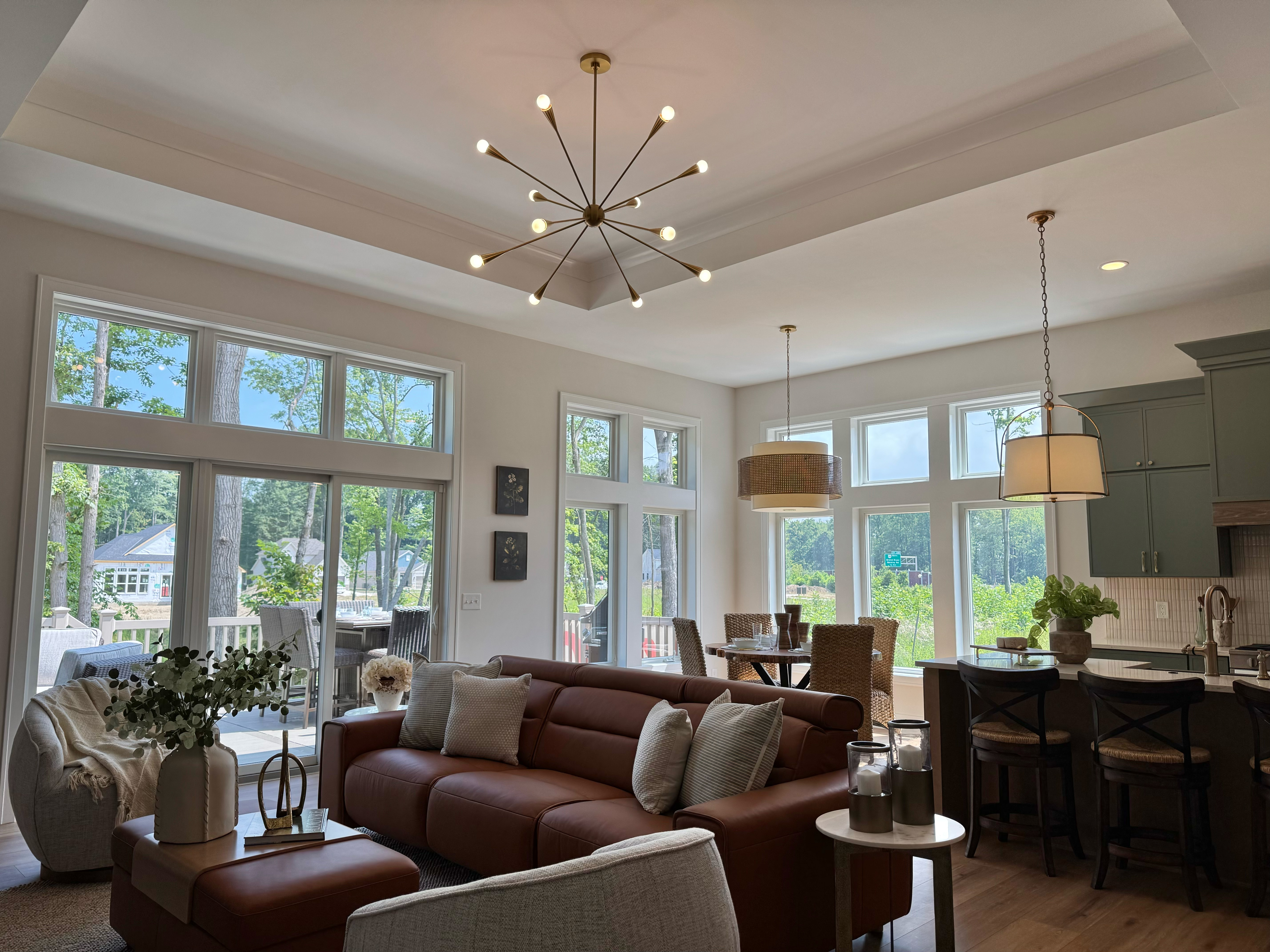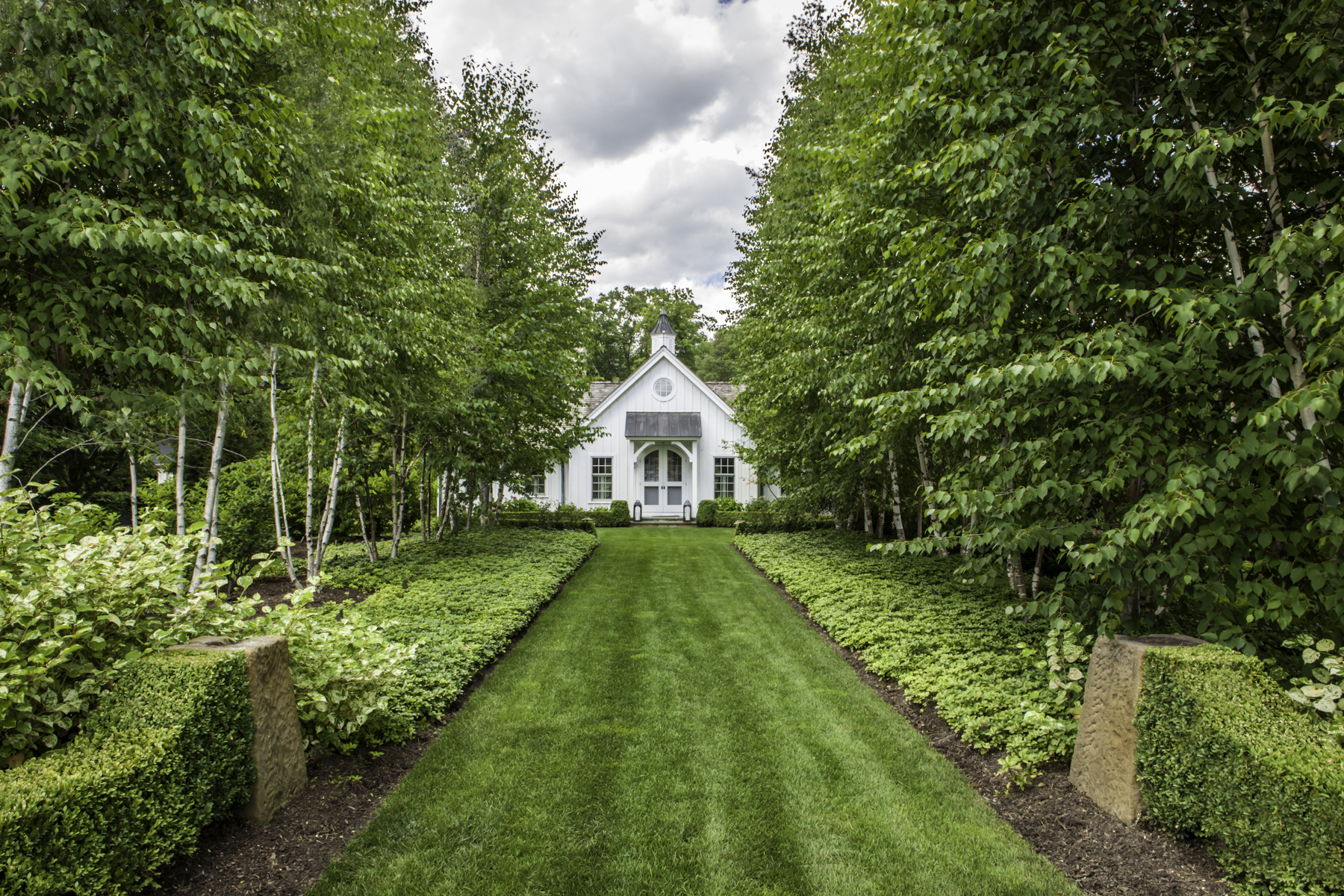A Mansion Called River Bend in Northeast Ohio Brings Immense Space to Entertain
by Lynne Thompson | Feb. 22, 2024 | 10:00 AM
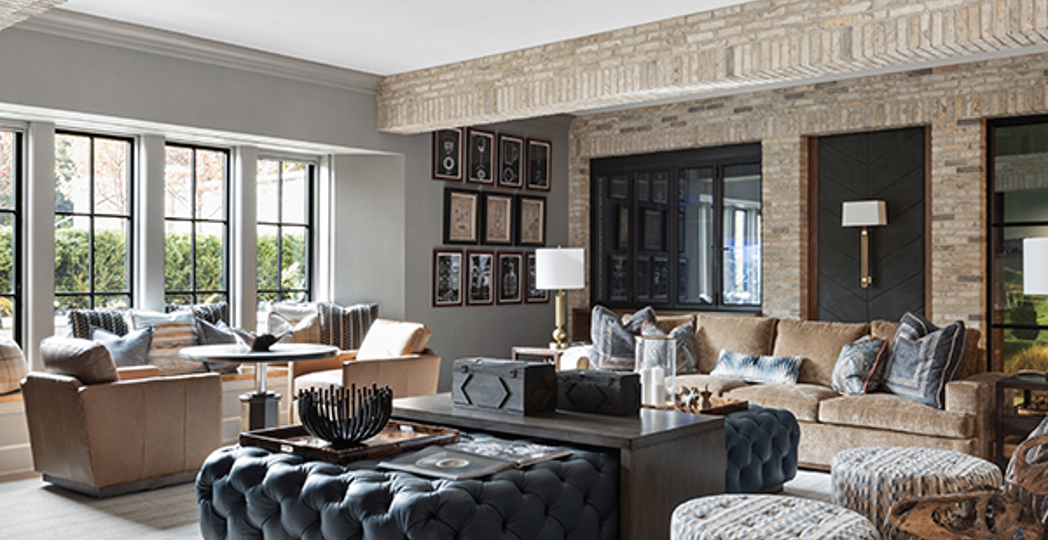
Amy Carruthers, Courtesy Laura Yeager Smith

The driveway winds through Dennis and Dawn Swit’s 19 wooded acres on the Chagrin River, over a bridge and under a freestanding porte cochere to their English country manor-style residence. The structure, a right angle of gabled limestone and quarry stone built on the property’s highest point, is imposing. An antique French fountain punctuates the granite-cobblestone motor court. Snow-scuppers and lighting rods rise from the slate and copper roof, the latter threatening to pierce the low-hanging clouds.
Visitors enter the home through doors framed by a massive arched transom and skylights. Inside is a cavernous hall boasting a vaulted beamed ceiling, limestone and gray-paneled walls and white-oak floors laid in a herringbone pattern highlighted by brass inlays. At the other end, another pair of arched glass doors, contemporary mirror images of the front counterparts, open onto a balcony overlooking one of three bluestone, brick paver and limestone terraces, along with a pond. Dennis explains that Chagrin Falls landscape designer David Thorn added the pond to transform a perpetual wet spot into a water feature. A waterfall spills into a stream that feeds a lower pond.
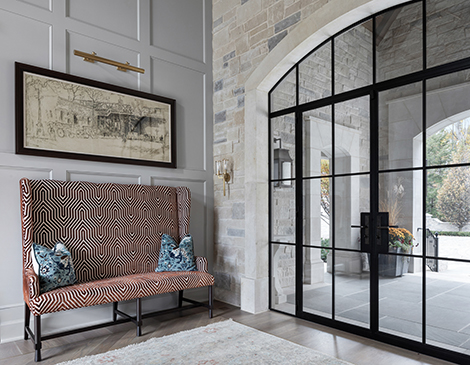
“We have a blue heron that comes and visits and eats all the fish,” Dennis says — a visitor that adds another touch of charm to River Bend.
The estate is the realization of a dream for the Swits, former owners of Loan Protector, a Solon-based provider of lender-placed insurance. “Dennis really wanted to build a house,” Dawn recalls as they sit in the breakfast nook of their spacious kitchen. That desire intensified during the renovation of a fixer-upper — a project that taught them not every design flaw can be corrected — and home search that followed. In January 2020, just as they were considering building in another East Side community, the Swits toured a colonial located just steps south of the motor court. The floor plan and decor were hopelessly out of date, but the surrounding acreage’s rustic beauty sold the couple on the property.
In June 2021, after 14 months of interviewing architects, builders and interior designers, reviewing elevations and submitting plans to the local architectural review board, contractors demolished the colonial. Over the next two-plus years, the Brookes & Henderson Building Co. of Bainbridge built a house designed by Chagrin Falls architect Richard Siegfried, one endowed with every amenity the Swits deemed necessary to host large gatherings with event-venue ease, accommodate overnight guests in five-star luxury, and pursue their own varied interests. Dawn is an avid golfer who qualified for the U.S. Golf Association Senior Women’s Amateur in 2022 and won the 2023 Cleveland Women’s Golf Association Championship. Dennis loves to cook and collects bourbon and cars.
“We needed to make it this size to fit in everything that we wanted,” Dennis explains. Size, he adds, wasn’t everything. They wanted the place to exude stately old-world permanence, yet invite visitors to sit down and “put [their] feet up.”
“We really wanted it to feel alive,” Dawn adds.
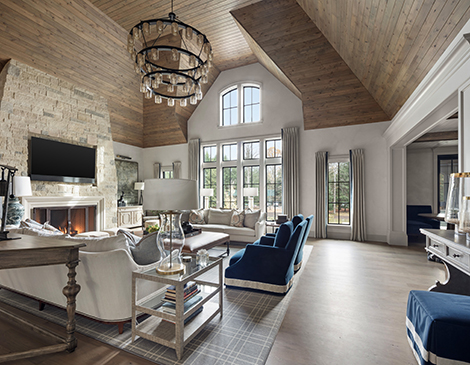
To create that sense of permanence, Laura Yeager Smith of Laura Yeager Smith Home & Design in Hudson employed architectural details and finishes found in grand homes of another time: tongue-and-groove ceilings; wire-brushed, stained-pine beams; cast-stone window casings; walnut woodwork; bathroom tile laid in intricate patterns; updated renderings of traditional lighting fixtures; the aforementioned white oak floors; and paneled and limestone-covered walls. She developed a palette of neutrals accented by shades of blue, drawing inspiration from images the Swits provided.
RELATED: Inside the Rebuild of a 6,500-Square-Foot Rocky River Tudor
About 75% of the furniture is custom sized – the pieces from the Swits’ previous home simply weren’t large enough to suit River Bend’s spaces. Dawn points to the great room, where two 112-inch-long sofas upholstered in a herringbone-textured oatmeal fabric and two sapphire blue velvet armchairs gather around an enormous saddle-colored leather cocktail ottoman, as an example. A metal and glass chandelier that looks like a wired version of something that could have hung over the Knights of the Round Table illuminates the arrangement.
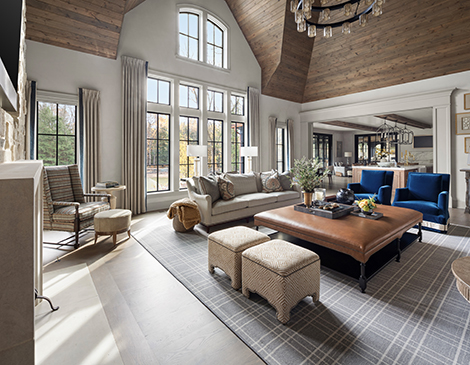
“We were very careful to make the scale of the lighting impactful in the home, to make the overall space not feel too big,” Laura says. Like the lighting, the oversized furnishings reduce the room to a human scale. And their updated traditional style, together with rustic touches like the stained-alder ceiling and limestone fireplace, contribute to the room’s relaxed vibe.
RELATED: A Cleveland Homeowner Sees His First Home as a Dream Come True
The great room opens to the kitchen, where a brilliant blue La Cornue range competes with a paneled-and-fluted walnut island topped in honed marble for focal-point status. A walnut-cased arch with panel detail leads to a prep kitchen where the ceiling, cabinetry, including the appliance-concealing panels, and walls were painted with Sherwin-Williams Seaworthy.
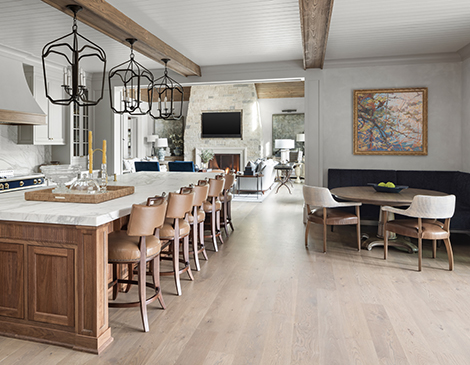
“This room is more compartmentalized,” Laura says. “So it’s an area where you can do something unexpected.”
The covered terrace off the kitchen houses another culinary venue: an outdoor kitchen with a hybrid gas and wood-burning pizza oven, gas griddle and two burners, warming drawer and grill with infrared rotisserie and charcoal smoker tray. The terrace is actually a four-season room thanks to its fireplace, heated bluestone floor, ceiling-mounted infrared heaters and clear acrylic panels that replace screens in cold weather. Its turret is occupied by a custom round table for eight. Dennis points out the lazy Susan in the center of the outdoor-safe Dekton tabletop, a feature that facilitates serving.
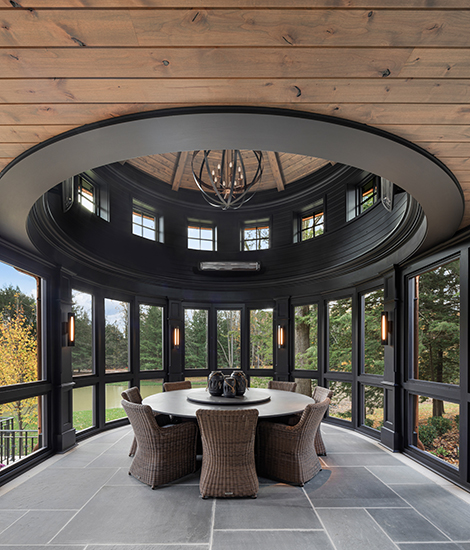
“We realized you would not be able to pass the food — or barely reach the middle,” Laura says of its development.
A hallway and trio of arches separate the great room from the dining room, distinguished by a groin-vaulted ceiling and walls finished in the same off-white lime paint that adds layered texture to the other first-floor living areas. Dennis opens two sets of walnut doors, one pair on either side of the carved-
limestone fireplace. One reveals a service bar — actually a length of the wet bar that stretches across the other side of the wall — where guests can order drinks during large functions.
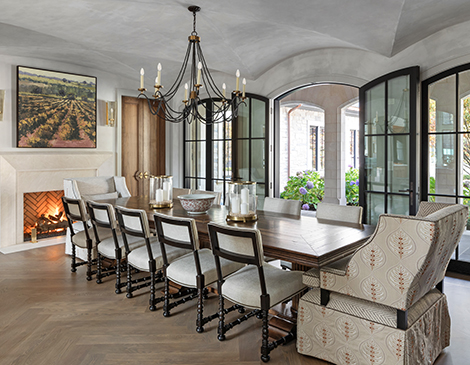
The other pair of doors provides access to the wet bar, the prep kitchen beyond, and a hall that extends to a mudroom and one of two, two-car garages. Doors along the way open to a pantry, powder room, small laundry for washing table linens and dish towels and an elevator.
The floor above this service wing houses a one-bedroom guest suite, second owners’ suite, two guest rooms with en suite baths and main laundry room. Dawn explains the placement of the “grand stair” in this part of the home rather than the entry hall. “We wanted the owners’ wing separated from the rest of the house,” she says.
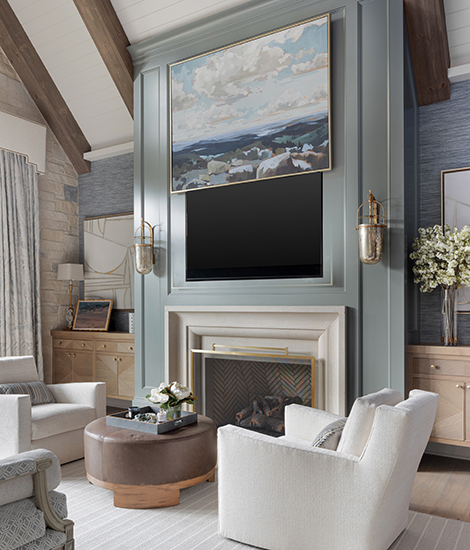
The owners’ wing is accessed via a hall off the entry that passes a powder room and closet big enough to serve as a coat check before ending in a vestibule. To the left is another small laundry room. To the right is the entrance to the grayish-blue, grass-papered bedroom, cleverly outfitted with a coffee bar concealed in gray-painted cabinetry. Dennis picks up a remote and demonstrates how the landscape painting over the fireplace lifts to reveal a television. But the standout is the Calacatta marble bathroom.
A chandelier of hand-blown glass globes resembling soap bubbles hangs over a floor inset of marble tile laid in an oval mosaic pattern. On one side is a makeup table built between banks of gray-painted cabinetry. On the other are his-and-hers vanities separated by arched glass doors. Inside is a bathing room featuring a freestanding oval tub and heated chaise lounge constructed of cast stone and glass mosaic tile. Dawn uses them to warm up after a cold day on the golf course. Another glass door opens to a steam shower with a heated bench, his-and-hers shower heads, and a chromotherapy rain head integrated into the AV speaker system.
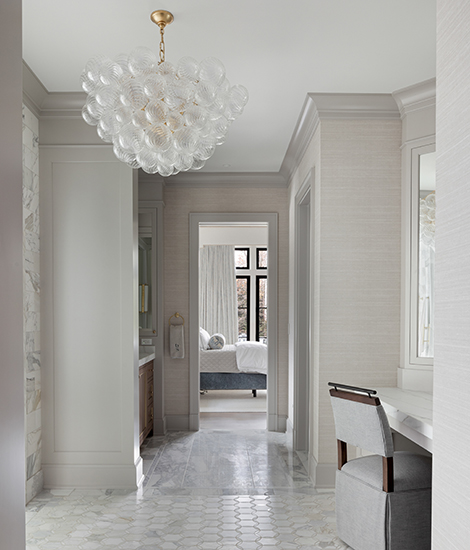
A door opposite the bathroom entry from the bedroom leads to his and hers dressing rooms — hers sleek and gray, his lined in walnut cabinetry with green-suede-wrapped drawer fronts. A stairwell walled in white shiplap leads to Dawn’s white office and sitting area. Dennis’s gray-paneled office, accented with insets of gray flannel wallcovering, is located off the entry hall. Although the Swits are retired, they remain involved in philanthropic organizations. He sits on the board of The Turn, which helps the physically-challenged return to the game of golf, while Dawn holds seats on the boards of the Northern Ohio Golf Association, Cleveland Animal Protective League and First Tee of Cleveland, a nonprofit that exposes local high schoolers to golf and the values it promotes.
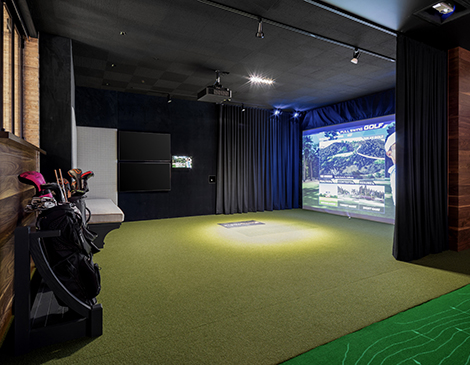
The lower-level entertainment area is accessed by elevator or stairs. The elevator opens to a hall next to a gray-paneled powder room modeled after a 1920s speakeasy bathroom and subway-tiled cat room for the Swits’ three cats. (Dennis calls the tiled area for bathing dogs “future-proofing” that’s currently used for cleaning litter boxes.) At one end of the hall is another pantry, an audio-visual room and one of the geothermally-heated house’s three mechanical rooms. The other terminates at a bourbon bar, where Dennis’s 300-bottle collection is displayed in walnut-and-brass cabinetry and sitting area. Shatterproof and soundproof windows in one brick wall frame views of a three-hole indoor putting green and Full Swing golf simulator.
I have a couple of girlfriends coming over tomorrow,” Dawn says. “We’re playing Pebble Beach.”
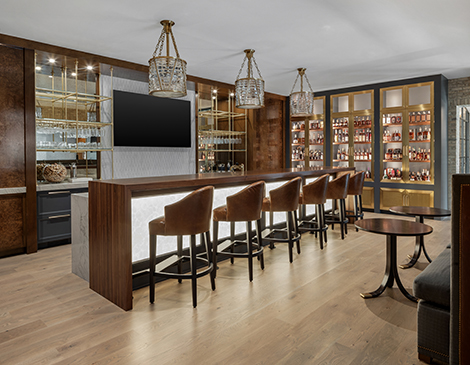
Next to the bourbon bar is a barrel-vaulted oak-ceilinged wine room with storage and display for 300 bottles. A rift-cut white oak table engraved with the River Bend logo on one side serves as a counter-height spot for unpacking crates and decanting bottles. Dennis opens a drawer outfitted as a mini-humidor for storing cigars. The couple and their guests do their tasting at a table just outside a wall of windows that separate the brick-walled room from the hall — the room is maintained at a constant 55 degrees.
The barrel-vaulted hall continues to walnut double doors inset with forest green chevron-patterned leather. Beyond are a rubber-floored exercise room and green marble mosaic-tile spa featuring an infrared sauna, cold plunge pool and tile shower.
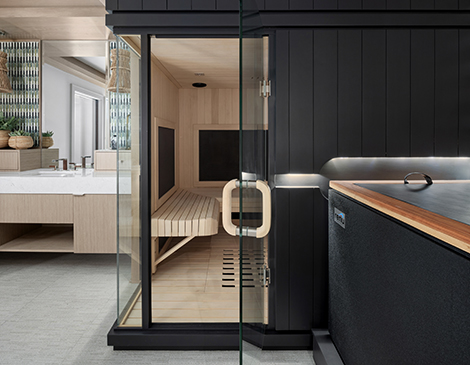
An adjoining lounge, together with the spa, double as a de facto pool house for the outdoor pool visible through a glass wall.
Outbuildings include a renovated two-bedroom, two-bath guest cottage and a car barn under construction where the property’s original house once stood. The first floor will have a workshop, wash bay and square footage to display at least eight cars. A lift is being installed to raise one car up above the others so it can be easily viewed through a glassed-walled second-floor poker room.
“When he [said], ‘Honey, can I have guys over for poker?’ at our old house, I would say, ‘No, I don’t want to deal with it,’” Dawn says. “Now he can just go to his man cave, and I don’t even have to know about it.”
Big as the house is, every room has been used since the Swits took up residence in September. Seventeen relatives, some of whom live in the area, stayed in the guest rooms and guest cottage over Thanksgiving weekend. And 150 people filled the first and ground floors for a holiday party. The couple envisions hosting fundraisers for the various nonprofits they support. They’ve discovered only one disadvantage to living large.
“You better remember where you put your phone,” Dennis says with amusement, “because now there’s a lot of places to look for your phone.”
Looking to make a dream — or part of one — a reality? Local contractors suggest factors to consider.
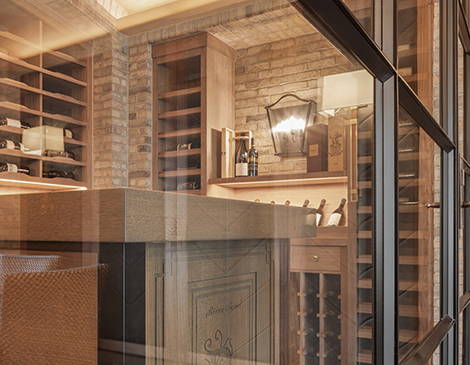
The Wine Room
Cost for the main component: $8,500 to $10,000 for a dedicated ducted climate-control system (including installation), says Bill Henderson, co-owner of the Brookes & Henderson Building Co. in Bainbridge. He typically installs that system in a room insulated with a 2-pound, closed-cell spray foam that acts as a “vapor barrier” to maintain the cooler temperatures and higher humidity levels. Laura Yeager Smith of Laura Yeager Smith Home & Design says some people rely on the inherent coolness of a basement room. “[But] if you care about your wine, you’re going to put in a climate-control system,” Henderson says.
Size: Smith suggests clients who waffle on the number of bottles to be stored allow enough square footage for at least 300. Amenities such as storage also factor into the sizing. “Some people want to do the tasting in the room,” she adds. “But more often than not, it’s [done] outside of the room. It’s chilly in the wine room.”
Storage: “Most of the wine-room racks are built so that the bottom goes in first [horizontally] at a slightly lifted angle so the wine is … against the cork,” Henderson says. “What you’re trying to prevent is the cork drying out.” Smith combines open and closed storage that can be used for other purposes, particularly in rooms housing budding collections or serving as more of a focal point.
Light: “You shouldn’t have a lot of direct light — or natural light at all — on the wine bottles,” Smith says. “So you wouldn’t want a window directly to the outside in a wine room” — unless, of course, it’s shuttered or curtained. She’s used low-voltage LED tape lighting under shelves to showcase bottles and supply enough illumination to read their labels.
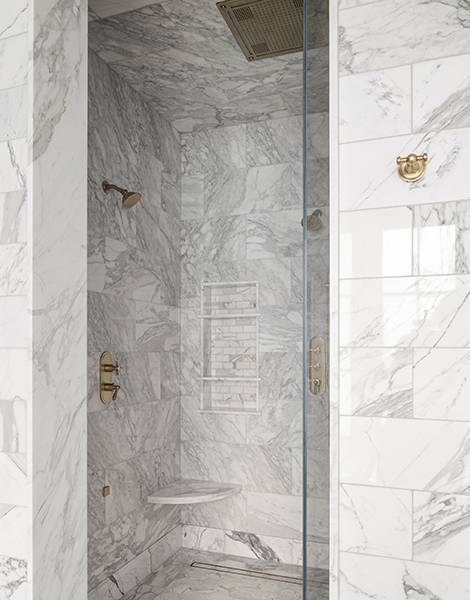
The Steam Shower
Cost: Starting at $11,000 for a 4-by-5-foot tile shower, says Bill Henderson, co-owner of the Brookes & Henderson Building Co. in Bainbridge. The steam generator alone starts at $3,500 (including installation), depending on the unit required for the space in which it is installed.
New or retrofit: Henderson’s cost estimate dispels the notion that a steam shower has to be bigger than the average stall “as long as you’ve got room to sit down.” he adds. But he describes an extra step to installation that goes beyond waterproofing to sealing so the steam won’t escape and damage the walls. “So it’s not usually a good idea to just retrofit an existing shower, even if it’s a tile one,” he says. “That step might not have been taken.” The steam shower, he adds, is completely enclosed by a tightly sealed door that reaches the ceiling with a transom-like glass panel that can be opened to vent steam after use. And the ceiling is finished in tile or another waterproof material and slanted so condensation runs down the ceiling, then a wall, instead of dripping on the user.
Materials: Laura Yeager Smith of Laura Yeager Smith Home & Design in Hudson notes that less-porous materials are best for finishing. “You can use natural stone,” she says. “But, like, a bright white marble probably wouldn’t be the best choice. It could absorb water over time and, if your water isn’t treated … you might end up with some rust lines in your stone.”
Ventilation: Henderson recommends installing an exhaust fan with a higher CFM – that’s cubic feet (of air, in this case) per minute — than the typical builder-grade bathroom unit to remove steam more efficiently. He notes that some people opt to install the fan inside the shower. “The problem with that is, the parts can rust,” he says. “So typically, we still put the fan outside of the shower.”
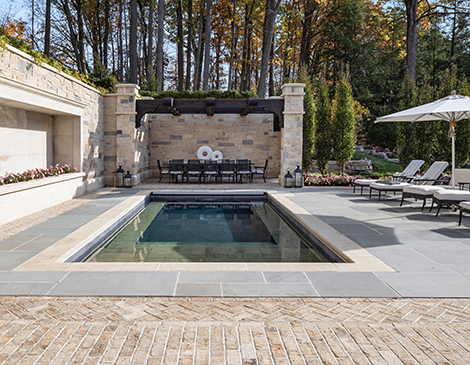
The In-Ground Outdoor Swimming Pool
Cost: Starting at $150,000 for a 15-by-30-foot concrete pool, including extending and connecting utilities, installing landscaping, etc., says Evan Smith, co-owner of Highland Construction Cleveland, a swimming pool contractor in Richfield.
Local zoning codes: Municipalities and townships have varying codes governing everything from pool size and placement to construction and design, right down to pool-surface color and lighting. Smith notes, for example, that most communities stipulate pools be located behind homes.
Access to property: “A lot of times, we’re putting in an access road to the backyard,” Smith says. “So just right off the rip, someone could be spending $5,000 to be able to get big dump trucks in the backyard to take the dirt out.”
Seasonal or year-round use: Components for pools used year-round should be located indoors. “If you have a power loss and all that equipment is outside, within an hour everything could be frozen up,” Smith warns.
RELATED: Bay Village Pool Deck Brings Resort Styles to Lake Erie Shores
Maintenance: Smith rattles off tasks such as brushing walls, vacuuming, emptying skimmers, washing and changing filters, and checking and balancing water chemistry. He describes the last job, completed at least weekly, as essential to the pool’s health and the people using it. “If you let the water chemistry get off, you can really start to harm not only the pool finish itself but your pool components — your pool filter, your pool heater, your sanitizer and really, your decking and everything around it.” Winterization includes draining about a foot of water out of the pool, blowing water out of pipes, heaters, filters, pumps, etc., and installing winterization plugs. Those who don’t want the hassle of doing that work should budget for a contractor to do it. Smith gives an estimate of $6,000 to $8,000 for his company to open a pool, service it for five months, and close it for the winter.
For more updates about Cleveland, sign up for our Cleveland Magazine Daily newsletter, delivered to your inbox six times a week. Cleveland Magazine is also available in print, publishing 12 times a year with immersive features, helpful guides and beautiful photography and design.
Trending
-
1
-
2
-
3
-
4
-
5

